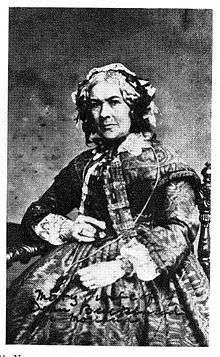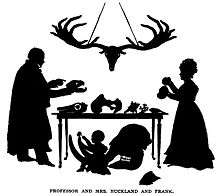Mary Buckland
| Mary Buckland, née Morland | |
|---|---|
 | |
| Born |
1797 Abingdon, England |
| Died | 1857 |
| Nationality | English |
| Fields | Paleontology |
| Spouse | William Buckland |
Mary Buckland, née Morland (born Abingdon 1797, died 1857),[1] was a British palaeontologist, marine biologist and scientific illustrator.[2]
Life

She was born in 1797 in Sheepstead House, Abingdon, to Benjamin Morland,[3] a solicitor.[4] Her mother died when she was a baby, and her father remarried, producing a large family of half-brothers and sisters. She spent much of her childhood in Oxford, living with a physician, Sir Christopher Pegge, and his wife.
The following romantic anecdote (recorded by Miss Caroline Fox in her journal for 8 October 1839) is told about how Mary met her future husband William Buckland:
Both were travelling in Dorsetshire and each were reading a new and weighty tome by the French naturalist Georges Cuvier. "They got into conversation, the drift of which was so peculiar that Dr. Buckland exclaimed, "You must be Miss Morland, to whom I am abut to deliver a letter of introduction.' He was right, and she soon became Mrs Buckland. She is an admirable fossil geologist, and makes midels in leather of some of the rare discoveries".[5]
In 1825[3] Mary Morland married William Buckland, who later became Dean of Westminster. Their honeymoon was a geological tour lasting a year, including visits to famous geologists and geological locations across Europe.[6] They had nine children, including Frank Buckland and author Elizabeth Oke Buckland Gordon. We know a lot about William Buckland from the biography written by Elizabeth. The children were exposed to their parents collections of fossils from an early age and at the age of 4 Frank could successfully identify the vertebrae of an ichthyosaurus.[7]

Mary was an accomplished illustrator,[6] producing illustrations for Georges Cuvier, a French palaeontologist, and for a work by William Conybeare, a British geologist. She also made models of fossils, and labelled fossils for an Oxford museum. She studied marine zoophytes using microscopes. She repaired broken fossils according to her husband's instructions.[8]
She assisted her husband by writing as he dictated, producing illustrations for his books, and taking notes of his observations. She assisted him when he was commissioned to contribute a volume to The Bridgewater Treatises. His contribution in 1836 was a mixture of geological and palaeontological science and philosophical reflections.[9] It is difficult to assess Mary Buckland's contributions to science, because so much of her work was involved with that of her husband.[3]
Mary Buckland amassed a vast collection of fossils and other specimens. She also taught in a village school in Islip, near the family's country home.
References
- ↑ Frith, Uta (7 February 2011). "Females, Fossils and Hyenas – part 1". Blogs: The repository. The Royal Society. Retrieved 24 September 2012.
- ↑ Burek, C. V. (2002). "Where are the Women in Science? A case study using women in the history of geology to develop a European curriculum" (PDF). In Gonzales, M. H. Proyecto Penelope – The role of the history of science in secondary education. Tenerife, Spain: Fundación Canaria Orotava de Historia de La Ciencia. pp. 214–221. Retrieved 26 September 2012.
- 1 2 3 Ogilvie, Marilyn Bailey (1986). "Buckland, Mary Morland". Women in science : antiquity through the nineteenth century : a biographical dictionary with annotated bibliography (4th print. ed.). Cambridge, Mass.: MIT Press. p. 49. ISBN 9780262650380.
- ↑ Frith, Uta (11 February 2011). "Females, Fossils and Hyenas – part 2". Blogs: The repository. The Royal Society. Retrieved 24 September 2012.
- ↑ Gordon, Elizabeth (1894). The life and Correspondence of William Buckland. London: John Murray. p. 91.
- 1 2 "William Buckland" (PDF). Learning more. Oxford University Museum of Natural History. Retrieved 24 September 2012.
- ↑ Bompas, George Cox (1909). Life of Frank Buckland. London: Thomas Nelson. p. 13.
- ↑ "Buckland, William". Dictionary of Scientific Biography. Cultural Heritage Language Technologies (with permission from Charles Scribners and Sons). 6 January 1946. Retrieved 24 September 2012.
- ↑ Haines, Catherine M. C. (2001). "Buckland, Mary née Morland". International women in science : a biographical dictionary to 1950. Santa Barbara, Calif. [u.a.]: ABC-CLIO. p. 48. ISBN 9781576070901.
Further reading
- Torrens, H.S. (2004). "Buckland (née Morland), Mary". Oxford Dictionary of National Biography. doi:10.1093/ref:odnb/46486. Retrieved 24 September 2012.
| Wikimedia Commons has media related to Mary Buckland. |